The Giants.com crew debates the best draft class in franchise history:
John Schmeelk: This is a really tough question. The best players in Giants history are spread out over a number of different drafts. My first criteria is the draft class must include a Hall of Fame or Ring of Honor caliber player. From there, I looked at those classes to see if there was another player of that caliber, or close to it, in the class.
There weren't a lot of great options. The Giants drafted Chris Snee the same year they acquired Eli Manning, but since Manning was not technically a draft pick in 2004, I hesitate to include him. Going back, 1993 jumps out to me even though the Giants didn't have a first round pick (they had used it on quarterback Dave Brown in the supplemental draft). Hall of Famer Michael Strahan was selected in the second round, and Ring of Honor member Jessie Armstead was selected in the eighth.
Billy Ard and Byron Hunt were drafted in 1981, the same year as Lawrence Taylor, but no one else pops from that class. Neither Carl Banks, Harry Carson nor Phil Simms had any other all-timers drafted the same year they were.
Going back to the pre-Super Bowl days, Spider Lockhart and Tucker Frederickson were picked in 1965. Sam Huff, Jim Katcavage and Don Chandler were drafted in 1956. Rosey Brown was a 27th round pick in 1953 but otherwise that class was barren. Frank Gifford was picked in the first round the year prior, but no one else of significance was selected that year.
I'm probably showing recency bias here, but I'm going to go with Michael Strahan and Jessie Armstead, two of the best players at their positions in their era and helped the Giants reach a Super Bowl. The Giants' best draft class was 1993.
View photos of Pro Football Hall of Famer and Giants legend Michael Strahan.


New York Giants defensive end Michael Strahan (92) returns a fumble 13 yards for a touchdown during an NFL game against the Seattle Seahawks at the Meadowlands in East Rutherford, N.J., Dec. 23, 2001. The Giants defeated the Seahawks 27-24. (AP Photo/NFL Photos/Evan Pinkus)

New York Giants quarterback Eli Manning, left, and Michael Strahan celebrate the Giants' 17-14 win over the New England Patriots in the Super Bowl XLII football game at University of Phoenix Stadium on Sunday, Feb. 3, 2008 in Glendale, Ariz. (AP Photo/Julie Jacobson)


Hall of Fame enshrinee Michael Strahan poses with his bust during the 2014 Pro Football Hall of Fame Enshrinement Ceremony on August 2, 2014 in Canton, OH. (AP Photo/Ben Liebenberg)

New York Giants defensive end Michael Strahan (92) reacts after sacking New England Patriots quarterback Tom Brady (12) during the third quarter of the Super Bowl XLII football game at University of Phoenix Stadium on Sunday, Feb. 3, 2008 in Glendale, Ariz. (AP Photo/Ross D. Franklin)


New York Giants Michael Strahan does his imitation of San Diego Chargers' Junior Seau as he taunts the Chargers' bench after sacking San Diego quarterback Ryan Leaf in the second quarter of the Giants' 34-16 victory Sunday, Sept. 27, 1998 in San Diego. (AP Photo/Lenny Ignelzi)

New York Giants defensive end Michael Strahan (92) sacks Baltimore Ravens quarterback Trent Dilfer (8) during Super Bowl XXXV on Jan. 28, 2001 at Raymond James Stadium in Tampa. The Baltimore Ravens defeated the New York Giants 34–7. (Allen Kee via AP)
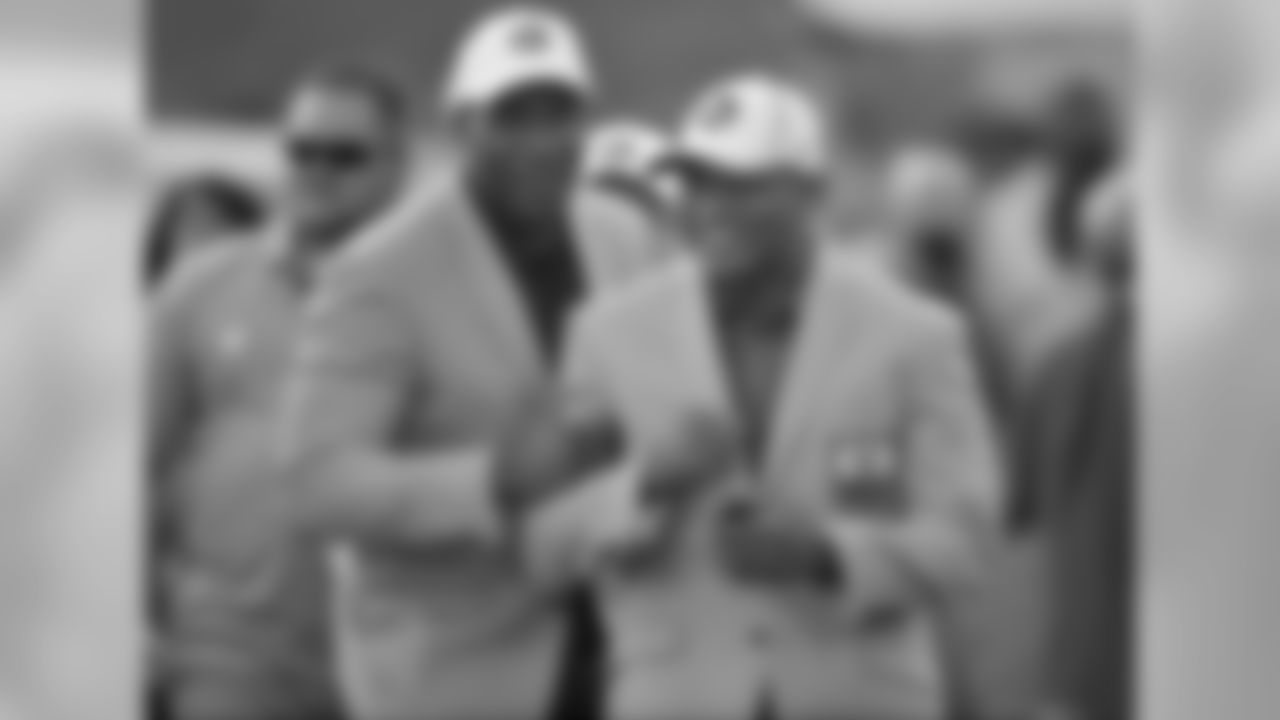
Inductees Michael Strahan, left, and Aeneas Williams talk prior to the Pro Football Hall of Fame exhibition NFL football game between the New York Giants and the Buffalo Bills Sunday, Aug. 3, 2014, in Canton, Ohio. New York won 17-13. (AP Photo/David Richard)

Michael Strahan has his #92 jersey retired at halftime during a week 12 football game against the Philadelphia Eagles on Sunday November 28th, 2021 in East Rutherford, New Jersey

New York Giants quarterback Eli Manning (10) talks with former teammates Shaun O'Hara, Michael Strahan, and Coach Tom Coughlin before anoucing his retirement to the media after after 16 seasons with the New York Giants at Quest Diagnostics Training Center on Friday January 23rd, 2020 in East Rutherford, New Jersey (Evan Pinkus via AP)

New York Giants quarterback Eli Manning (10) hugs Michael Strahan before announcing his retirement to the media after after 16 seasons with the New York Giants at Quest Diagnostics Training Center on Friday January 23rd, 2020 in East Rutherford, New Jersey (Evan Pinkus via AP)


Michael Strahan attends a screening of "A Lifetime of Sundays" at The Paley Center for Media on Wednesday, Sept. 18, 2019, in New York. (Photo by Charles Sykes/Invision/AP)


Michael Strahan before the NFL NFC Championship football game between the San Francisco 49ers and the Green Bay Packers Sunday, Jan. 19, 2020, in Santa Clara, Calif. (AP Photo/Marcio Jose Sanchez)

Michael Strahan arrives at the Oscars on Sunday, March 4, 2018, at the Dolby Theatre in Los Angeles. (Photo by Jordan Strauss/Invision/AP)

Michael Strahan attends a special screening of "Black Panther" at the Museum of Modern Art on Tuesday, Feb. 13, 2018, in New York. (Photo by Evan Agostini/Invision/AP)

New York Giants Hall of Famer Michael Strahan is honored during an NFL football game against the Indianapolis Colts at MetLife Stadium on Monday, November 3, 2014 in East Rutherford, New Jersey. Indianapolis won 40-24. (AP Photo/Aaron M. Sprecher)

Host Michael Strahan, left, talks to Lindsey Vonn at the Kids' Choice Sports Awards on Thursday, July 11, 2019, at the Barker Hangar in Santa Monica, Calif. (Photo by Chris Pizzello/Invision/AP)

Former New York Giants players Michael Strahan, (92), Antonio Pierce (58), left, and Jeff Feagles (18) , right, and Shaun O'Hara, (60) watch as Tom Coughlin, center, holds the Super Bowl trophy during a halftime ceremony of an NFL football game between the New York Giants and the Detroit Lions Monday, Sept. 18, 2017, in East Rutherford, N.J. (AP Photo/Bill Kostroun)

GLENDALE, AZ - FEBRUARY 3: Michael Strahan #92 of the New York Giants celebrates on the field against the New England Patriots during Super Bowl XLII at University of Phoenix Stadium on February 3, 2008 in Glendale, AZ. The Giants defeated the Patriots 17-14. (AP Photo/Tom Hauck)

Inductee Michael Strahan talks during the 2014 Pro Football Hall of Fame Enshrinement Ceremony Saturday, Aug. 2, 2014, in Canton, Ohio. (AP Photo/David Richard)

New York Giants defensive end Michael Strahan (92) celebrates with former Pittsburgh Steelers quarterback Terry Bradshaw after winning the NFL Championship Jan. 14, 2001 at the Meadowlands. (Al Messerschmidt via AP)

Baltimore Ravens quarterback Trent Dilfer (8) is tackled by New York Giants defensive end Michael Strahan (92) during Super Bowl XXXV on Jan. 28, 2001 at Raymond James Stadium in Tampa. The Baltimore Ravens defeated the New York Giants 34–7. (Allen Kee via AP)

New York Giants Michael Strahan during an NFL football game against the Tennessee Titans in East Rutherford,NJ at Giants Stadium Sunday, Dec.1, 2002. (AP Photo/Tom DiPace)

Defensive end Michael Strahan (92) of the New York Giants watches play on August 31, 2001 against the Baltimore Ravens in Baltimore, Maryland. The Ravens won 38 - 9. (AP Photo / Al Messerschmidt))

New York Giants defensive end Michael Strahan (92) watches pre-game workouts before an NFL game against the Kansas City Chiefs at the Meadowlands in East Rutherford, N.J., Dec. 20, 1998. The Giants defeated the Chiefs 28-7. (AP Photo/NFL Photos/Evan Pinkus)

Tampa Bay Buccaneers linebacker Hardy Nickerson (56) and New York Giants defensive end Michael Strahan (92) collapse on Tennessee Oilers running back Eddie George (27) during the NFL Pro Bowl, a 29-24 AFC victory on February 1, 1998, at Aloha Stadium in Honolulu, Hawaii. (AP Photo / Al Messerschmidt)

Michael Strahan #92 of the New York Giants is interviewed by Terry Bradshaw after the Giants defeated the New England Patriots 17-14 during Super Bowl XLII on February 3, 2008 at the University of Phoenix Stadium in Glendale, Arizona. (AP Photo/Ben Liebenberg)

New York Giants defensive end Michael Strahan is interviewed by Terry Bradshaw after winning the NFC championship game against the Minnesota Vikings Jan. 14, 2001, in East Rutherford, N.J. The Giants defeated the Vikings 41-0. (Allen Kee via AP)

New York Giants Michael Strahan during an NFL football game against the Tennessee Titans in East Rutherford,NJ at Giants Stadium Sunday, Dec.1, 2002. (AP Photo/Tom DiPace)

Defensive end Michael Strahan (92) of the New York Giants sets on defense against the Philadelphia Eagles September 4, 1994. (AP Photo / Al Messerschmidt)

Inductee Michael Strahan talks during the 2014 Pro Football Hall of Fame Enshrinement Ceremony Saturday, Aug. 2, 2014, in Canton, Ohio. (AP Photo/David Richard)

2014 Pro Football Hall of Fame class member Michael Strahan is introduced at halftime of Super Bowl XLVIII at Metlife Stadium on Sunday, Feb. 2, 2014, in East Rutherford, N.J. (AP Photo/Ben Liebenberg)

New York Giants defensive end Michael Strahan (92) recovers a fumble by New York Jets running back Richie Anderson, left, in the fourth quarter at Giants Stadium in East Rutherford, N.J., Aug. 20, 1994. (AP Photo/Luc Novovitch)

Defensive end Michael Strahan (92) of the New York Giants sets on defense against the Cinncinnati Bengals December 11, 1994. (AP Photo / Al Messerschmidt)

Michael Gelman, left, Kelly Ripa, Michael Strahan, Jordan Knight and Nick Carter celebrate after competing in a Tough Mudder obstacle race on ABC's "Live with Kelly and Michael" on Thursday, Sept. 4, 2014 in New York. The episode airs on Friday, Sept. 5. (Photo by Charles Sykes/Invision/AP)

Host Michael Strahan, second left, announces Kel Michell, left, winner of the Pillow Fight Fight Night challenge as NFL player Rob Gronkowski, of the New England Patriots, from right, and David Dobrik look on at the Kids' Choice Sports Awards on Thursday, July 11, 2019, at the Barker Hangar in Santa Monica, Calif. (Photo by Chris Pizzello/Invision/AP)

FOX Sports personality Terry Bradshaw, a former Pittsburgh Steeler and member of the Pro Football Hall of Fame, talks to New York Giants defensive end Michael Strahan following the NFC Championship Game, a 41 - 0 Giants victory over the Minnesota Vikings on Jan. 14, 2001, at Giants Stadium in East Rutherford, NJ. (Al Messerschmidt via AP)

New York Giants defensive end Michael Strahan (92) celebrates during an NFL game against the Dallas Cowboys at the Meadowlands, East Rutherford, N.J., Oct. 18, 1999. The Giants defeated the Cowboys 13-10. (AP Photo/NFL Photos/Evan Pinkus)

New York Giants defensive end Michael Strahan takes a break during training camp drills, Sunday, July 23, 2000 in Albany, N.Y. (AP Photo/Dave Oxford)

Host Michael Strahan speaks at the 20th annual Critics' Choice Movie Awards at the Hollywood Palladium on Thursday, Jan. 15, 2015, in Los Angeles. (Photo by John Shearer/Invision/AP)

Jared Leto, left, and Michael Strahan speak at the 20th annual Critics' Choice Movie Awards at the Hollywood Palladium on Thursday, Jan. 15, 2015, in Los Angeles. (Photo by John Shearer/Invision/AP)

Host Michael Strahan, right, wipes Shuan White's face after getting slimed at the Kids' Choice Sports Awards on Thursday, July 11, 2019, at the Barker Hangar in Santa Monica, Calif. (Photo by Chris Pizzello/Invision/AP)

Defensive end Michael Strahan (92) of the New York Giants sets on defense against the San Diego Chargers. (AP Photo / Al Messerschmidt)

Fox Sports analyst Michael Strahan talks with San Francisco 49ers defensive end Nick Bosa (97) before an NFL NFC Championship against the Green Bay Packers, Sunday, Jan. 19, 2020, in Santa Clara, Calif. San Francisco 49ers won 37-20. (Peter Read Miller via AP)

New York Giants defensive end Michael Strahan (92) rushes the pocket during the NFL Championship Jan. 14, 2001 at the Meadowlands. (Al Messerschmidt via AP)

New York Giants defensive end Michael Strahan (92) sacks San Francisco 49ers kicker Cody Pickett (3) on Sunday, November 6, 2005, in San Francisco, California. The Giants defeated the 49ers 24-6. (AP Photo/Al Golub)

Michael Strahan pumps up the New York Giants huddle before the 2014 Pro Football Hall of Fame game between the Buffalo Bills and New York Giants at Fawcett Stadium on Sunday, Aug. 3, 2014, in Canton, Ohio. (AP Photo/Ben Liebenberg)

New York Giants defensive end Michael Strahan (92) watches pre-game workouts before an NFL game against the Philadelphia Eagles at the Meadowlands, East Rutherford, N.J., Dec. 28, 2002. The Giants defeated the Eagles 10-7 in overtime. (AP Photo/NFL Photos/Evan Pinkus)

New York Giants, Michael Strahan (92) during a game against the Kansas City Chief on December 20, 1998 at Giants Stadium in East Rutherford, New Jersey. The Giants beat the Chiefs 28-7. Michael Strahan played for 15 years all with the Giants. He was a 7-time Pro Bowler and was inducted to the Pro Football Hall of Fame in 2014.(AP Photo/David Durochik)

Inductee Michael Strahan talks during the 2014 Pro Football Hall of Fame Enshrinement Ceremony Saturday, Aug. 2, 2014, in Canton, Ohio. (AP Photo/David Richard)

New York Giants former defensive end Michael Strahan (92) reacts during halftime ceremony to recognize the 10th anniversary of the Giants victory in Super Bowl XLII during a NFL football game in East Rutherford, N.J. on Monday, September 18, 2017. (Kirby Lee via AP)

Carmelo Anthony, left, and Michael Strahan speak during the 2015 Kids' Choice Sports Awards show at Pauley Pavilion on Thursday, July 16, 2015 in Los Angeles. (Photo by Paul A. Hebert/Invision/AP)

Pro Football Hall of Fame defensive end Michael Strahan, left, speaks after he received his Hall of Fame Ring of Excellence as Lawrence Taylor watches him during a halftime ceremony of an NFL football game between the New York Giants and the Indianapolis Colts, Monday, Nov. 3, 2014, in East Rutherford, N.J. (AP Photo/Bill Kostroun)

Michael Strahan, left, and Adam Levine greet eachother at the Oscars on Sunday, Feb. 22, 2015, at the Dolby Theatre in Los Angeles. (Photo by Matt Sayles/Invision/AP)

New York Giants former coach Tom Coughlin (right) and former defensive end Michael Strahan (92) carry the Lombardi Trophy onto the field during halftime ceremony to recognize the 10th anniversary of the Giants' victory in Super Bowl XLII at a NFL football game in East Rutherford, N.J. on Monday, September 18, 2017. (Kirby Lee via AP)

Michael Strahan arrives at The Metropolitan Museum of Art Costume Institute Benefit Gala, celebrating the opening of "Manus x Machina: Fashion in an Age of Technology" on Monday, May 2, 2016, in New York. (Photo by Charles Sykes/Invision/AP)
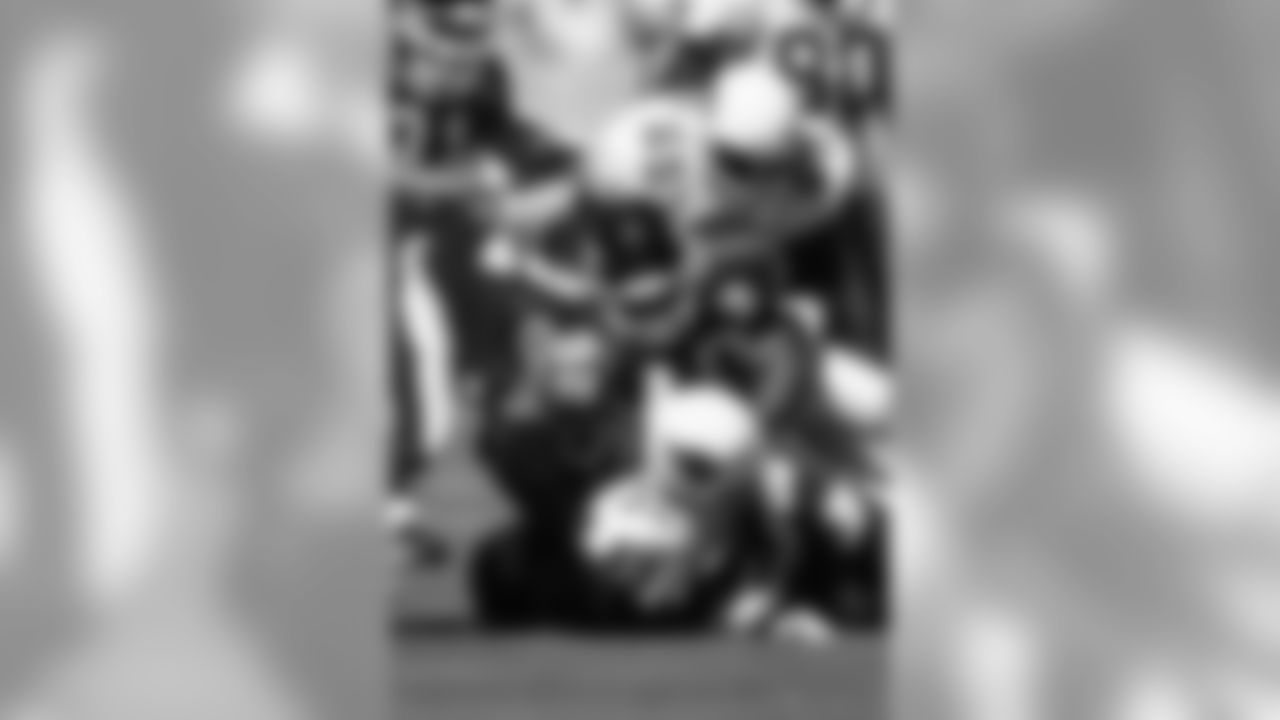
New York Giants defensive end Michael Strahan (92) is seen in action during an NFL game against the Arizona Cardinals Oct. 10, 1999, in Glendale, Ariz. (Allen Kee via AP)

Michael Strahan, left, and Salma Hayek speak on the red carpet at the Oscars on Sunday, March 4, 2018, at the Dolby Theatre in Los Angeles. (Photo by Charles Sykes/Invision/AP)

New York Giants Hall of Famer Michael Strahan is honored during an NFL football game against the Indianapolis Colts at MetLife Stadium on Monday, November 3, 2014 in East Rutherford, New Jersey. Indianapolis won 40-24. (AP Photo/Aaron M. Sprecher)

New York Giants defensive end Michael Strahan (92) watches play Aug. 29, 2002 at the Meadowlands. The Giants defeated the Baltimore Ravens 13 - 0 to finish the preseason 3-2. (Al Messerschmidt via AP)

Aaron Paul, left, talks to former NFL football player Michael Strahan before the NFL Super Bowl XLVIII football game between the Seattle Seahawks and the Denver Broncos, Sunday, Feb. 2, 2014, in East Rutherford, N.J. (AP Photo/Evan Vucci)

New York Giants defensive end Michael Strahan and quarterback Kerry Collins embrace after winning NFL Championship Jan. 14. 2001 at the Meadowlands. (Al Messerschmidt via AP)

New York Giants defensive end Michael Strahan (92) sacks Seattle Seahawks quarterback Matt Hasselbeck (8) at the Meadowlands, East Rutherford, N.J., Dec. 23, 2001. The Giants defeated the Seahawks 27-24. (AP Photo/NFL Photos/Evan Pinkus)

Host Michael Strahan gets slimed on stage at the Kids' Choice Sports Awards at UCLA's Pauley Pavilion on Thursday, July 17, 2014, in Los Angeles. (Photo by John Shearer/Invision/AP)

New York Giants defensive end Michael Strahan (92) is seen in action during Super Bowl XXXV on Jan. 28, 2001 at Raymond James Stadium in Tampa. The Baltimore Ravens defeated the New York Giants 34–7. (Allen Kee via AP)

New York Giants defensive end Michael Strahan (92) upends Baltimore Ravens quarterback Trent Dilfer (8) in Super Bowl XXXV in Tampa. The Baltimore Ravens defeated the Giants 34 - 7. January 28, 2001. (AP Photo / Al Messerschmidt)

New York Giants defensive end Michael Strahan (92) tackles Minnesota Vikings running back Robert Smith (26) during the Jan. 14, 2001 NFC playoff game against the in the Meadowlands. (AP Photo / Al Messerschmidt)

Hall of Fame inductee Michael Strahan poses with his bust during the Pro Football Hall of Fame enshrinement ceremony Saturday, Aug. 2, 2014, in Canton, Ohio. (AP Photo/Tony Dejak)

New York Giants former coach Tom Coughlin (left) and former defensive end Michael Strahan (92) carry the Lombardi Trophy onto the field during halftime ceremony to recognize the 10th anniversary of the Giants' victory in Super Bowl XLII at a NFL football game in East Rutherford, N.J. on Monday, September 18, 2017. (Kirby Lee via AP)

Former New York Giants player Michael Strahan, lower left, reacts as Giants defensive end Justin Tuck bows after speaking during a ceremony for the Super Bowl XLVI championship New York Giants at City Hall in New York, Tuesday, Feb. 7, 2012. (AP Photo/Kathy Willens)

Director Spike Lee, left, speaks to former New York Giants football player Michael Strahan, center during, a break in NBA bsketball game action during the first half between the New York Knicks and the New Orleans Hornets, Wednesday, March 2, 2011, at Madison Square Garden in New York. (AP Photo/Mary Altaffer)

Former New York Giants defensive end Michael Strahan, center, talks with members of his old team during a preseason NFL football game against the Carolina Panthers at Giants Stadium in East Rutherford, N.J., Monday, Aug. 17, 2009. (AP Photo/Bill Kostroun)

New York Giants' defensive end Michael Strahan celebrates after running back an interception of a tipped pass 44-yards for a touchdown to beat the Philadelphia Eagles 23-17 in overtime Sunday, Oct. 31, 1999 in Philadelphia. (AP Photo/George Widman)

Tampa Bay Buccaneers wide receiver Reidel Anthony (85) gets flipped over by New York Giants defenders Phillippi Sparks (22) and Michael Strahan (92) after making a first quarter reception Sunday afternoon Sept. 12, 1999 at Raymond James Stadium in Tampa, Fla. (AP Photo/Steve Nesius)

San Francisco 49ers vs. New York Giants at Candlestick Park Monday, November 30, 1998. 49ers beat Giants 31-7. San Francisco 49ers quarterback Steve Young (8) makes pass as New York Giants defensive end Michael Strahan (92) attempts to stop him. (AP Photo/Al Golub)

New York Giants defensive end Michael Strahan celebrates after sacking Washington Redskins quarterback Heath Shuler in the first quarter Sunday, Dec. 10, 1995, at Giants Stadium in East Rutherford, N.J. The Giants defeated the Redskins, 20-13. (AP Photo/Bill Kostroun)

Flavor Flav, Michael Strahan and Ghostface Killah pose backstage at the 2008 VH1 Hip Hop Honors at Hammerstein Ballroom in New York, Thursday, Oct. 2, 2008. (Evan Agostini/AP Images for VH1)

NFL athletes Eli Manning, right, and and Michael Strahan, left, accept the award for best game for the New York Giants victory in Super Bowl XLII from Terrell Owens, center, at the ESPYs Awards on Wednesday July 16, 2008 in Los Angeles. (AP Photo/Kevork Djansezian)

Michael Strahan on stage at the ESPYs Awards on Wednesday July 16, 2008 in Los Angeles. (AP Photo/Kevork Djansezian)
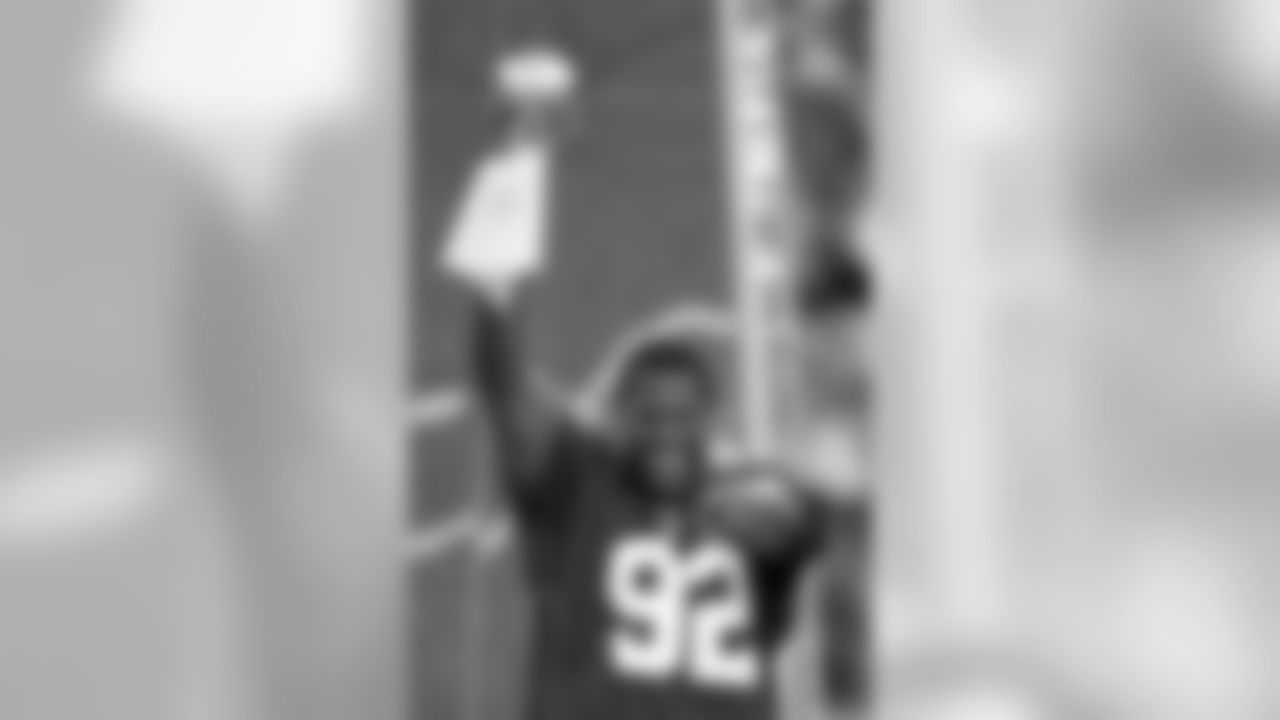
Retired New York Giant Michael Strahan points as he holds up the Vince Lombardi trophy during a ceremony before the defending NFL Super Bowl champions' season-opening football game against the Washington Redskins at Giants Stadium in East Rutherford, N.J., Thursday, Sept. 4, 2008. (AP Photo/Seth Wenig)

Terry Bradshaw, left, Michael Strahan, second from left, Howie Long, second from right, and Jimmy Johnson, right laugh while responding to questions during a news conference Tuesday, June 24, 2008 in New York. Strahan, the charismatic former New York Giants defensive end, who retired earlier this month, will join the FOX network's NFL pregame show. (AP Photo/Frank Franklin II)

New York Giants Michael Strahan talks about his retirement from football during a news conference at Giants Stadium in East Rutherford, N.J., Tuesday, June 10, 2008. Strahan says his decision to retire after 15 seasons arose from a desire to leave on his own terms _ and finishing with a Super Bowl title didn't hurt. (AP Photo/Mike Derer)

In this photo provided by Starpix, sport legends Arnold Palmer, left, Michael Strahan, center and musician Carlos Santana attend the Samsung 7th annual Four Seasons of Hope Gala in New York, Monday, June 16, 2008. (AP Photo/Dave Allocca, Starpix)

New York Giants Michael Strahan talks about his retirement from football during a news conference at Giants Stadium in East Rutherford, N.J., Tuesday, June 10, 2008. (AP Photo/Mike Derer)

New York Giants defensive end Michael Strahan shows off the Vince Lombardi trophy and his new Super Bowl championship football ring after receiving the ring during a ceremony at Tiffany's, Thursday, May 29, 2008 in New York. (AP Photo/Jason DeCrow)

New York Giants Michael Strahan wears his Super Bowl ring as he talks about his retirement from football during a news conference at Giants Stadium in East Rutherford, N.J., Tuesday, June 10, 2008. Strahan retires after 15 years with the Giants and winning the Super Bowl. (AP Photo/Mike Derer)

New York Giants Michael Strahan talks about his retirement from football during a news conference at Giants Stadium in East Rutherford, N.J., Tuesday, June 10, 2008. Strahan says his decision to retire after 15 seasons arose from a desire to leave on his own terms _ and finishing with a Super Bowl title didn't hurt. (AP Photo/Mike Derer)

FOR USE AS DESIRED WITH YEAR END--FILEIn this Feb. 5, 2008 file photo, New York Giants defensive end Michael Strahan leaps into the air to share a team motto with fans who gathered at City Hall to honor the team after they beat the New England Patriots to win the Super Bowl in New York. (AP Photo/Julie Jacobson/FILE)

New York Giants defensive end Michael Strahan leaps into the air to share a team motto with fans who gathered at City Hall to honor the team after they beat the New England Patriots to win the Super Bowl Tuesday, Feb. 5, 2008 in New York. (AP Photo/Julie Jacobson)

New York Giants defensive end Michael Strahan shows off his new Super Bowl ring after receiving it during a ceremony at Tiffany's Thursday, May 29, 2008 in New York. (AP Photo/Jason DeCrow)

New York Giants defensive end Michael Strahan, left, and wide receiver Amani Toomer pose with the Vince Lombardi trophy and their new Super Bowl football championship rings after receiving the rings during a ceremony at Tiffany's, Thursday, May 29, 2008 in New York. (AP Photo/Jason DeCrow)

Host Michael Strahan speaks at the 20th annual Critics' Choice Movie Awards at the Hollywood Palladium on Thursday, Jan. 15, 2015, in Los Angeles. (Photo by John Shearer/Invision/AP)

New York Giants defensive end Michael Strahan, left, talks with Whoopi Goldberg during a ceremony honoring the team Tuesday, Feb. 5, 2008 at City Hall in New York. The Giants beat the New England Patriots 17-14 in Super Bowl XLII on Sunday. (AP Photo/Julie Jacobson)

New York Giants defensive end Michael Strahan shows the Vince Lombardi Trophy as he rides through the Super Bowl victory parade Tuesday, Feb. 5, 2008 in New York. (AP Photo/Gary He)

New York Giants' head coach Tom Coughlin, center, holds the Vince Lombardi trophy as Michael Strahan, left, and Eli Manning, right, look on during a parade celebrating the Giants Super Bowl victory over the New England Patriots Tuesday, Feb. 5, 2008 in New York. (AP Photo/Frank Franklin II)

New York Giants players Michael Strahan, left, holding the Vince Lombardi trophy, and Eli Manning, celebrate during a Super Bowl parade in New York on Tuesday, Feb. 5, 2008. The Giants defeated the New England Patriots 17-14 in Sunday's National Football League championship game. (AP Photo/Frank Franklin II)

New York Giants defensive end Michael Strahan celebrates after the Giants beat the New England Patriots 17-14 in the Super Bowl XLII football game on Sunday, Feb. 3, 2008, in Glendale, Ariz.(AP Photo/David J. Phillip)

New York Giants players Michael Strahan, left, and Eli Manning, holding the Vince Lombardi trophy, celebrate during a Super Bowl parade in New York on Tuesday, Feb. 5, 2008. The Giants defeated the New England Patriots 17-14 in Sunday's National Football League championship game. (AP Photo/Mike Groll)

New York Giants players Michael Strahan, left, and Eli Manning, holding the Vince Lombardi trophy, celebrate during a Super Bowl parade in New York on Tuesday, Feb. 5, 2008. The Giants defeated the New England Patriots 17-14 in Sunday's National Football League championship game. ((AP Photo/Frank Franklin II)

New England Patriots quarterback Tom Brady (12) falls after being hit by New York Giants defensive end Michael Strahan (92) after a pass during the first quarter of the Super Bowl XLII football game at University of Phoenix Stadium on Sunday, Feb. 3, 2008 in Glendale, Ariz. (AP Photo/Julie Jacobson)

New York Giants players Michael Strahan, left, and quarterback Eli Manning celebrate during a Super Bowl parade in New York on Tuesday, Feb. 5, 2008. The Giants defeated the New England Patriots, 17-14, in Sunday's National Football League championship game. (AP Photo/Mike Groll)

New York Giants quarterback Eli Manning, left, and Michael Strahan celebrate after the Giants beat the New England Patriots 17-14 in the Super Bowl XLII football game on Sunday, Feb. 3, 2008, in Glendale, Ariz. (AP Photo/Eric Gay)

New York Giants defensive end Michael Strahan walks through the locker room at Giants Stadium in East Rutherford, N.J, Tuesday, Feb. 5, 2008. The Super Bowl champions were assembling for a bus ride to New York City for a victory parade. (AP Photo/Mike Derer)

New York Giants defensive end Michael Strahan (92) reacts during the Giants 17-14 win over the New England Patriots in the Super Bowl XLII football game at University of Phoenix Stadium on Sunday, Feb. 3, 2008 in Glendale, Ariz. (AP Photo/Stephan Savoia)

New York Giants defensive end Michael Strahan (92) holds the Vince Lombardi trophy after the Giants beat the New England Patriots 17-14 to win the Super Bowl XLII football game in Glendale, Ariz, on Sunday, Feb. 3, 2008. (AP Photo/Eric Gay)

New York Giants defensive end Michael Strahan (92) celebrates after the Giants beat the New England Patriots 17-14 to win the Super Bowl XLII football game in Glendale, Ariz, on Sunday, Feb. 3, 2008. (AP Photo/Matt Slocum)

New York Giants defensive end Michael Strahan (92) and teammate Kawika Mitchell celebrate after the Giants beat the New England Patriots 17-14 in the Super Bowl XLII football game on Sunday, Feb. 3, 2008, in Glendale, Ariz.(AP Photo/Charlie Riedel)

New York Giants' Michael Strahan (92) and Osi Umenyiora (72) celebrate after Strahan sacked New England Patriots quarterback Tom Brady, right, during the third quarter of the Super Bowl XLII football game at University of Phoenix Stadium on Sunday, Feb. 3, 2008 in Glendale, Ariz. (AP Photo/Matt Slocum)

New England Patriots quarterback Tom Brady (12) is sacked New York Giants defensive end Michael Strahan (92) during the third quarter of the Super Bowl XLII football game at University of Phoenix Stadium on Sunday, Feb. 3, 2008 in Glendale, Ariz. (AP Photo/Paul Sancya)

New York Giants defensive end Michael Strahan celebrates after the Giants beat the New England Patriots 17-14 in the Super Bowl XLII football game on Sunday, Feb. 3, 2008, in Glendale, Ariz.(AP Photo/David J. Phillip)

New York Giants defensive end Michael Strahan holds the Vince Lombardi trophy after the Giants beat the New England Patriots 17-14 to win the Super Bowl XLII football game in Glendale, Ariz, on Sunday, Feb. 3, 2008. (AP Photo/Eric Gay)

New York Giants defensive end Michael Strahan (92) dives on New England Patriots quarterback Tom Brady (12) in the second quarter during the Super Bowl XLII football game at University of Phoenix Stadium on Sunday, Feb. 3, 2008 in Glendale, Ariz. Brady was sacked on the play. (AP Photo/Stephan Savoia)

New York Giants defensive end Michael Strahan holds the Vince Lombardi trophy after the Giants beat the New England Patriots 17-14 to win the Super Bowl XLII football game in Glendale, Ariz, on Sunday, Feb. 3, 2008. (AP Photo/Eric Gay)

FILE In this Feb. 3, 2008 file photo, New York Giants defensive end Michael Strahan (92) reacts after sacking New England Patriots quarterback Tom Brady (12) in the third quarter during the Super Bowl XLII football game at University of Phoenix Stadium in Glendale, Ariz. Seven-time Pro Bowl defensive end Michael Strahan is retiring after a 15-year career, capped by a Super Bowl title with the New York Giants in February. The 36-year-old Strahan, the NFL's active leader in sacks, informed the Giants on Monday June 9, 2008. (AP Photo/David Duprey, File)

New York Giants defensive end Michael Strahan (92) reacts after sacking New England Patriots quarterback Tom Brady (12) in the third quarter during the Super Bowl XLII football game at University of Phoenix Stadium on Sunday, Feb. 3, 2008 in Glendale, Ariz. (AP Photo/David Duprey)

New York Giants defensive end Michael Strahan celebrates after the Giants beat the New England Patriots 17-14 in the Super Bowl XLII football game on Sunday, Feb. 3, 2008, in Glendale, Ariz. (AP Photo/David Duprey)

FILE In this Jan. 30, 2008 file photo, New York Giants defensive end Michael Strahan reacts while answering a question about the gap in his teeth during a media availability session in Chandler, Ariz. Seven-time Pro Bowl defensive end Michael Strahan is retiring after a 15-year career, capped by a Super Bowl title with the New York Giants in February. The 36-year-old Strahan, the NFL's active leader in sacks, informed the Giants on Monday June 9, 2008. (AP Photo/Julie Jacobson, File)

New York Giants defensive end Michael Strahan (92) and the rest of the team take the field before the Super Bowl XLII football game against the New England Patriots at University of Phoenix Stadium on Sunday, Feb. 3, 2008 in Glendale, Ariz. (AP Photo/David Duprey)

New York Giants defensive end Michael Strahan, right, crosses his fingers while answering questions from the media Thursday, Jan. 31, 2008 in Chandler, Ariz. The Giants will play the New England Patriots in Super Bowl XXLII on Sunday in Glendale, Ariz. (AP Photo/Julie Jacobson)

New York Giants defensive end Michael Strahan answers questions during a press conference Monday, Jan. 28, 2008 in Chandler, Ariz. The Giants will play the New England Patriots in the Super Bowl on Sunday. (AP Photo/Julie Jacobson)

New York Giants defensive end Michael Strahan answers during media day for the Super Bowl XLII football game Tuesday, Jan. 29, 2008, in Glendale, Ariz,. (AP Photo/Charlie Riedel)

New York Giants defensive end Michael Strahan video tapes member of the media before answering questions during a media availability, Wednesday, Jan. 30, 2008 in Chandler, Ariz. The Giants play the New England Patriots in Super Bowl XLII on Sunday, Feb. 3 in Glendale, Ariz. (AP Photo/Julie Jacobson)

New York Giants defensive end Michael Strahan answers during media day for the Super Bowl XLII football game Tuesday, Jan. 29, 2008, in Glendale, Ariz,. (AP Photo/Charlie Riedel)

New York Giants defensive end Michael Strahan is surrounded as he answers questions during media day for the Super Bowl XLII football game Tuesday, Jan. 29, 2008, in Glendale, Ariz,. (AP Photo/Charlie Riedel)

New York Giants defensive end Michael Strahan answers a question during media day for the Super Bowl XLII football game Tuesday, Jan. 29, 2008, in Glendale, Ariz,. (AP Photo/Stephan Savoia)
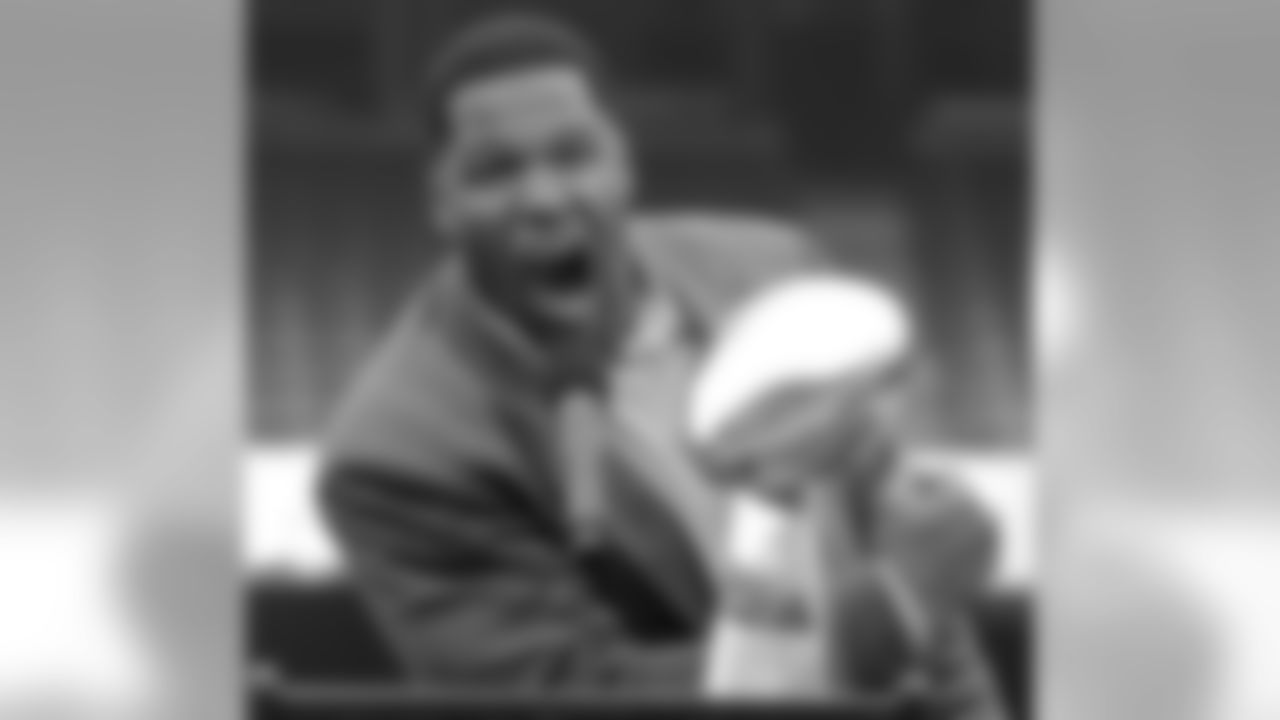
New York Giants' Michael Strahan talks to fans at a celebration rally Tuesday, Feb. 5, 2008 at Giants Stadium in East Rutherford, N.J. The New York Giants beat the New England Patriots 17-14 in Super Bowl XLII on Sunday. (AP Photo/Bill Kostroun)

New York Giants' Michael Strahan after the NFC Championship football game Sunday, Jan. 20, 2008, in Green Bay, Wis. (AP PhotoDavid J. Phillip)

New York Giants defensive end Michael Strahan arrives with his teammates Monday, Jan. 28, 2008, at Sky Harbor International Airport in Phoenix. The Giants will face the New England Patriots in Super Bowl XLII in Glendale, Ariz., on Sunday. (AP Photo/Matt York)

New York Giants defensive end Michael Strahan videotapes his teammates as they arrive Monday, Jan. 28, 2008, at Sky Harbor International Airport in Phoenix. The Giants will face the New England Patriots in NFL football's Super Bowl XLII in Glendale, Ariz., on Sunday. (AP Photo/Matt York)

FILE- In this file photo taken Jan. 24, 2008, New York Giants defensive ends Michael Strahan, left, and Osi Umenyiora walks out to the bubble for football practice in East Rutherford, N.J. (AP Photo/Bill Kostroun, FILE)

New York Giants' Michael Strahan celebrates with fans after the NFC Championship football game against the Green Bay Packers in Green Bay, Wis., Sunday Jan. 20, 2008 (AP Photo/David Duprey)

Ann Mara, mother of New York Giants owner John Mara, poses for a picture with defensive end Michael Strahan after the Giant win over Green Bay at the NFC Championship football game Sunday, Jan. 20, 2008, in Green Bay, Wis. (AP PhotoDavid J. Phillip) (AP PhotoDavid J. Phillip)

Ann Mara, mother of New York Giants owner John Mara, talks with defensive end Michael Strahan after the Giant win over Green Bay at the NFC Championship football game Sunday, Jan. 20, 2008, in Green Bay, Wis. (AP PhotoDavid J. Phillip)

New York Giants quarterback Eli Manning celebrates with defensive end Michael Strahan (92) after the NFC Championship football game against the Green Bay Packers Sunday, Jan. 20, 2008, in Green Bay, Wis. The Giants won 23-20 in overtime. (AP Photo/David Duprey)

New York Giants Madison Hedgecock (39) celebrates with defensive end Michael Strahan (92) after the NFC Championship football game against the Green Bay Packers Sunday, Jan. 20, 2008, in Green Bay, Wis. The Giants won 23-20 in overtime. (AP Photo/David Duprey)

New York Giants coach Tom Coughlin smiles as he stands in the locker room with players Michael Strahan, left, and Eli Manning, right, after their 23-20 overtime win over the Green Bay Packers in the NFC Championship football game Sunday, Jan. 20, 2008, in Green Bay, Wis. (AP Photo/David J. Phillip)

Green Bay Packers quarterback Brett Favre (4) walks off the field past New York Giants defensive end Michael Strahan, right, after throwing an interception in overtime in the NFC Championship football game Sunday, Jan. 20, 2008, in Green Bay, Wis. The Giants won 23-20. (AP Photo/David J. Phillip)

New York Giants quarterback Eli Manning celebrates with defensive end Michael Strahan (92) after the NFC Championship football game against the Green Bay Packers Sunday, Jan. 20, 2008, in Green Bay, Wis. The Giants won 23-20 in overtime. (AP Photo/David Duprey)

New York Giants defensive end Michael Strahan kisses the George S. Halas Trophy after his team's 23-20 overtime win over the Green Bay Packers in the NFC Championship football game Sunday, Jan. 20, 2008, in Green Bay, Wis. (AP Photo/David J. Phillip)

New York Giants defensive end Michael Strahan holds the George S. Halas Trophy after his team's 23-20 overtime win over the Green Bay Packers in the NFC Championship football game Sunday, Jan. 20, 2008, in Green Bay, Wis. (AP Photo/David J. Phillip)

New York Giants defensive end Michael Strahan looks on during the NFC Championship football game against the Green Bay Packers, Sunday, Jan. 20, 2008, in Green Bay, Wis. (AP Photo/Mike Roemer)

New York Giants kicker Lawrence Tynes (9) celebrates with teammates after kicking a field goal in overtime during the NFC Championship football game against the Green Bay Packers, Sunday, Jan. 20, 2008, in Green Bay, Wis. The Giants won 23-20 and advance to the Super Bowl against the New England Patriots. Giants' Michael Strahan is at right. (AP Photo/David J. Phillip)

New York Giants defensive end Michael Strahan (92) argues with line judge John Hussey (35) in the first quarter of an NFC divisional playoff football game against the Dallas Cowboys, Sunday, Jan. 13, 2008, in Irving, Texas. (AP Photo/Tony Gutierrez)

New York Giants defensive end Michael Strahan answers questions during a news conference after practice at Giants Stadium Friday, Jan. 18, 2008 in East Rutherford, N.J. The Giants will play the Green Bay Packers in the NFC Championship game on Sunday.(AP Photo/Julie Jacobson)

New York Giants defensive end Michael Strahan (92) lets out a yell as he leaves the field following a 21-17 win over the Dallas Cowboys in an NFC divisional playoff football game, Sunday, Jan. 13, 2008, in Irving, Texas. (AP Photo/Tony Gutierrez)

New York Giants defensive end Michael Strahan before the start of an NFC divisional playoff football game against the Dallas Cowboys, Sunday, Jan. 13, 2008, in Irving, Texas. (AP Photo/David J. Phillip)

New York Giants cornerback R.W. McQuarters (25) and defensive end Michael Strahan (92) celebrate their 21-17 win over the Dallas Cowboys in an NFC divisional playoff football game, Sunday, Jan. 13, 2008, in Irving, Texas. (AP Photo/David J. Phillip)

New York Giants Michael Strahan (92) recovers a fumble by the Miami Dolphins Cleo Lemon (17) during their NFL football game at Wembley Stadium in London, Sunday, Oct. 28, 2007. The game was the first NFL regular season game played in Europe. (AP Photo/Kirsty Wigglesworth)

New England Patriots quarterback Tom Brady (12) is brought down by New York Giants defensive end Michael Strahan after Brady released a pass, as Patriots' Ryan O'Callaghan looks on during the third quarter of an NFL football game at Giants Stadium in East Rutherford, N.J., on Saturday, Dec. 29, 2007. (AP Photo/Bill Kostroun)

Andre Reed, Ray Guy, Aeneas Williams, Claude Humphrey, Derrick Brooks, Walter Jones, and Michael Strahan are seen before the 2014 Pro Football Hall of Fame game between the Buffalo Bills and New York Giants at Fawcett Stadium on Sunday, Aug. 3, 2014, in Canton, Ohio. (AP Photo/Ben Liebenberg)

New York Giants' Sam Madison, left, sacks Chicago Bears quarterback Rex Grossman, center, with the help of Osi Umenyiora (72) and Michael Strahan during the second quarter of a football game Sunday, Dec. 2, 2007, in Chicago. (AP Photo/Jerry Lia)

New York Giants' Michael Strahan celebrates as he leaves the field after the Giants defeated the Atlanta Falcons 31-10 in a football game Monday, Oct. 15, 2007 in Atlanta. (AP Photo/John Amis)

Philadelphia Eagles kicker David Akers , left, walks off the field after his failed 57-yard field goal-attempt against the New York Giants with seconds to go in the second half of their football game Sunday, Dec. 9, 2007, in Philadelphia. The Giants won, 16-13. At right is Michael Strahan. (AP Photo/Rusty Kennedy)

New York Jets Leon Washington, left, is grabbed by New York Giants Justin Tuck as Michael Strahan (92) reaches out during the first quarter of their football game at Giants Stadium in East Rutherford, N.J., Sunday, Oct. 7, 2007. (AP Photo/Ed Betz)

New York Giants' Michael Strahan, right, celebrates with Antonio Pierce after Strahan sacked Philadelphia Eagles quarterback Donovan McNabb during second quarter NFL football Sunday, Sept. 30, 2007 at Giants Stadium in East Rutherford, N.J. The Giants had 12 sacks as they beat the Eagles 16-3. (AP Photo/Bill Kostroun)

New York Giants defensive end Michael Strahan (92) and center Shaun O'Hara celebrate after beating the Washington Redskin 24-17 in an NFL football game at the FedEx Field in Landover, Md., Sunday, Sept. 23, 2007. (AP Photo/Manuel Balce Ceneta)

New York Giants' Michael Strahan celebrates after sacking Philadelphia Eagles quarterback Donovan McNabb during second quarter NFL football Sunday, Sept. 30, 2007 at Giants Stadium in East Rutherford, N.J. The Giants beat the Eagles 16-3. (AP Photo/Bill Kostroun)

New York Giants defensive end Michael Strahan, right, talks with Philadelphia Eagles quarterback Donovan McNabb (5) after the NFL football game in East Rutherford, N.J. on Sunday, Sept. 30, 2007. The Giants won 16-3. (AP Photo/Tim Larsen)

Green Bay Packers quarterback Brett Favre, right, passes the ball as he is pressured by New York Giants defensive end Michael Strahan (92) during first quarter NFL football Sunday, Sept. 16, 2007 at Giants Stadium in East Rutherford, N.J. Favre completed 29-of-38 passes for 286 yards and three touchdowns as the Packers beat the Giants 35-13. The victory allowed Favre to become the winningest quarterback in NFL history.(AP Photo/Bill Kostroun)

San Francisco 49ers quarterback Trent Dilfer (12) is hit by New York Giants defensive end Osi Umenyiora, rear, as defensive end Michael Strahan (92) closes in during first quarter NFL football Sunday, Oct. 21, 2007 at Giants Stadium in East Rutherford, N.J. (AP Photo/Bill Kostroun)

New York Giants defensive end Michael Strahan smiles during football mini-camp Thursday, June 14, 2007, in East Rutherford, N.J. (AP Photo/Bill Kostroun)

Indianapolis Colts quarterback Peyton Manning (18) points out the defense before taking the snap from center Jake Scott as New York Giants defensive tackle Michael Strahan (92) looks on during first quarter NFL football Sunday night, Sept. 10, 2006 at Giants Stadium in East Rutherford, N.J. (AP Photo/Bill Kostroun)

Former New York Giants defensive end Michael Strahan is introduced during the 2014 Pro Football Hall of Fame Gold Jacket dinner at the Civic Center in Canton, Ohio on Aug. 1, 2013. (AP Photo/Ben Liebenberg)

New York Giants defensive end Michael Strahan celebrates after pressuring Tampa Bay Buccaneers quarterback Bruce Gradkowski to throw an incomplete pass on a fourth down play during fourth quarter NFL football Sunday, Oct. 29, 2006 at Giants Stadium in East Rutherford, N.J. The Giants beat the Buccaneers, 17-3. (AP Photo/Bill Kostroun)

Washington Redskins quarterback Mark Brunell is sacked by New York Giants defensive end Michael Strahan (92) during second quarter of an NFL football Sunday, Oct. 8, 2006 at Giants Stadium in East Rutherford, N.J. (AP Photo/Bill Kostroun)

New York Giants' Michael Strahan, right, talks to NFL commissioner Roger Goodell at Giants football practice Wednesday, Sept. 6, 2006, in East Rutherford, N.J. (AP Photo/Bill Kostroun)

New York Giants defensive end Michael Strahan cheers on the defense during the third quarter of their pre-season football game against the Baltimore Ravens , Friday, Aug. 11, 2006, in Baltimore. Strahan did not play in the game.(AP Photo/Chris Gardner)

New York Giants defensive end Michael Strahan walks in to the University at Albany's (N.Y.) gym, where the football team is gathering for its training camp, Thursday, July 27, 2006, in Albany, N.Y. (AP Photo/Jim McKnight)

Dallas Cowboys quarterback Drew Beldsoe is sacked by New York Giants left end Michael Strahan in the fourth quarter of the Cowboys 17-10 loss to the Giants, Sunday, Dec. 4, 2005, at Giants Stadium in East Rutherford, N.J. The two teams were vying for sole possession of first place in the NFC East. (AP Photo/Kathy Willens)

New York Giants defensive end Michael Strahan celebrates after sacking Dallas Cowboys quarterback Drew Bledsoe, rear during the third quarter Sunday, Dec. 4, 2005 at Giants Stadium in East Rutherford, N.J. The Giants won 17-10. (AP Photo/Bill Kostroun)

Seattle Seahawks head coach Pete Carroll speaks with Fox Sports analyst Michael Strahan while holding the Vince Lombardi Trophy following Super Bowl XLVIII against the Denver Broncos at MetLife Stadium on February 2, 2014 in East Rutherford, New Jersey. The Seahawks won 43-8. (AP Photo/Todd Rosenberg)

New York Giants defensive end Michael Strahan sacks Dallas Cowboys quarterback Drew Bledsoe (11) during the third quarter as Cowboys tackle Rob Petitti, right, attempts to block Strahan Sunday, Dec. 4, 2005 at Giants Stadium in East Rutherford, N.J. The Giants won 17-10. (AP Photo/Bill Kostroun)

New York Giants owner Steven Tisch gestures to the sky as he walks off the field with Michael Strahan after the Giants beat the Philadelphia Eagles, 27-17, Sunday, Nov. 20, 2005, at Giants Stadium in East Rutherford, N.J. Tisch's father Preston Robert Tisch passed away on Tuesday. (AP Photo/Bill Kostroun)

New York Giants defensive end Michael Strahan (92) rests during an NFL game against the San Francisco 49ers, Nov. 6, 2005 in San Francisco. (AP Photo/Greg Trott)

New York Giants defensive end Michael Strahan, front, celebrates after sacking Dallas Cowboys quarterback Drew Bledsoe, left rear, during the third quarter Sunday, Dec. 4, 2005, at Giants Stadium in East Rutherford, N.J. Cowboys guard Larry Allen is behind Strahan. The Giants won, 17-10. (AP Photo/Bill Kostroun)

New York Giants defensive end Michael Strahan (92) greets quarterback Eli Manning (10) after a score during an NFL game against the San Francisco 49ers, Nov. 6, 2005 in San Francisco. (AP Photo/Greg Trott)

Dallas Cowboys head coach Bill Parcells, right, and New York Giants Michael Strahan (92) greet each other after their game in Irving, Texas, Sunday, Oct. 16 , 2005. The Cowboys won in overtime 16-13. (AP Photo/Amy Conn-Gutierrez)

New York Giants' Michael Strahan reacts to the fans as he leaves the field after the Giants beat the Arizona Cardinals, 42-19, Sunday, Sept. 11, 2005, at Giants Stadium in East Rutherford, N.J. (AP Photo/Bill Kostroun)

New York Giants' Jeremy Shockey, right, congratulates Michael Strahan after Strahan intercepted a pass in the end zone during the second quarter against the New York Jets Friday night, Aug. 26, 2005 at Giants Stadium in East Rutherford, N.J. Looking on is Giants' Damane Duckett (99). (AP Photo/Bill Kostroun)

New York Jets quarterback Chad Pennington, right, fumbles the ball as he is hit by New York Giants defensive end Michael Strahan, left, during the second quarter Friday night, Aug. 26, 2005 at Giants Stadium in East Rutherford, N.J. (AP Photo/Bill Kostroun)

New York Giants' defensive end Michael Strahan (92) reacts after sacking Chicago Bears' quarterback Craig Krenzel in the second quarter of play on Sunday November, 7, 2004 at Giants Stadium in East Rutherford. Strahan will miss the rest of the Giants' season with a torn pectoral muscle. Strahan, the NFL's all-time single-season sacks leader, was hurt in the third quarter of a 28-21 loss to the Chicago Bears (AP Photo/Michael Kim)

New York Giants' Willie Beamon (21) and Michael Strahan (92) congratulates Kicker Brad Daluiso (3) on his 52-yard field goal in the second quarter of their NFL game against the Cincinnati Bengals, Dec. 11, 1994 at Giants Stadium in East Rutherford, N.J. (AP Photo/L.M. Otero)

New York Giants defensive end Michael Strahan, left, recovers a fumble as he fights Cleveland Browns quarterback Jeff Garcia for the ball during the fourth quarter Sunday, Sept. 26, 2004, at Giants Stadium in East Rutherford. The ball was snapped over Garcia's head. The Giants won, 27-10. (AP Photo/Bill Kostroun)

New York Giants defensive end Michael Strahan celebrates as he leaves the field after the Giants beat the Washington Redskins, 20-14, Sunday, Sept. 19, 2004 at Giants Stadium in East Rutherford. (AP Photo/Bill Kostroun)

New York Giants defensive end Michael Strahan celebrates as he carries the ball off the field after beatint the Cleveland Browns, 27-10, Sunday, Sept. 26, 2004, at Giants Stadium in East Rutherford. (AP Photo/Bill Kostroun)

New York Giants defensive end Michael Strahan (92) upends Baltimore Ravens quarterback Trent Dilfer (8) in Super Bowl XXXV in Tampa. The Baltimore Ravens defeated the Giants 34 - 7 January 28, 2001. (AP Photo / Al Messerschmidt)

Retired New York Giant Michael Strahan waves tot he fans after being inducted into the Giants Ring of Honor at halftime against the Chicago Bears in a week 4 NFL football game at the New Meadowlands Stadium in East Rutherford, New Jersey on Sunday October 3, 2010 (AP Photo/Evan Pinkus)

New York Giants, Michael Strahan (92) during a game against the Chicago Bears on September 17, 2000 at Soldier Field in Chicago, Illinois. The Giants beat the Bears 14-7. Michael Strahan played for 15 years all with the Giants. He was a 7-time Pro Bowler and was inducted to the Pro Football Hall of Fame in 2014.(AP Photo/David Durochik)

Inductees Aeneas Williams, Derrick Brooks, Claude Humphrey, Michael Strahan, Walter Jones, Ray Guy and Andre Reed, from left, pose with their busts at the Pro Football Hall of Fame enshrinement ceremony Saturday, Aug. 2, 2014, in Canton, Ohio (AP Photo/Tony Dejak)

New York Giants, Michael Strahan (92) during a game against the Kansas City Chief on December 20, 1998 at Giants Stadium in East Rutherford, New Jersey. The Giants beat the Chiefs 28-7. Michael Strahan played for 15 years all with the Giants. He was a 7-time Pro Bowler and was inducted to the Pro Football Hall of Fame in 2014.(AP Photo/David Durochik)

New York Giants quarterback Eli Manning, right, embraces former teammate Michael Strahan during a ceremony for the NFL football Super Bowl XLVI champions at City Hall in New York, Tuesday, Feb. 7, 2012. (AP Photo/Craig Warga, Pool)
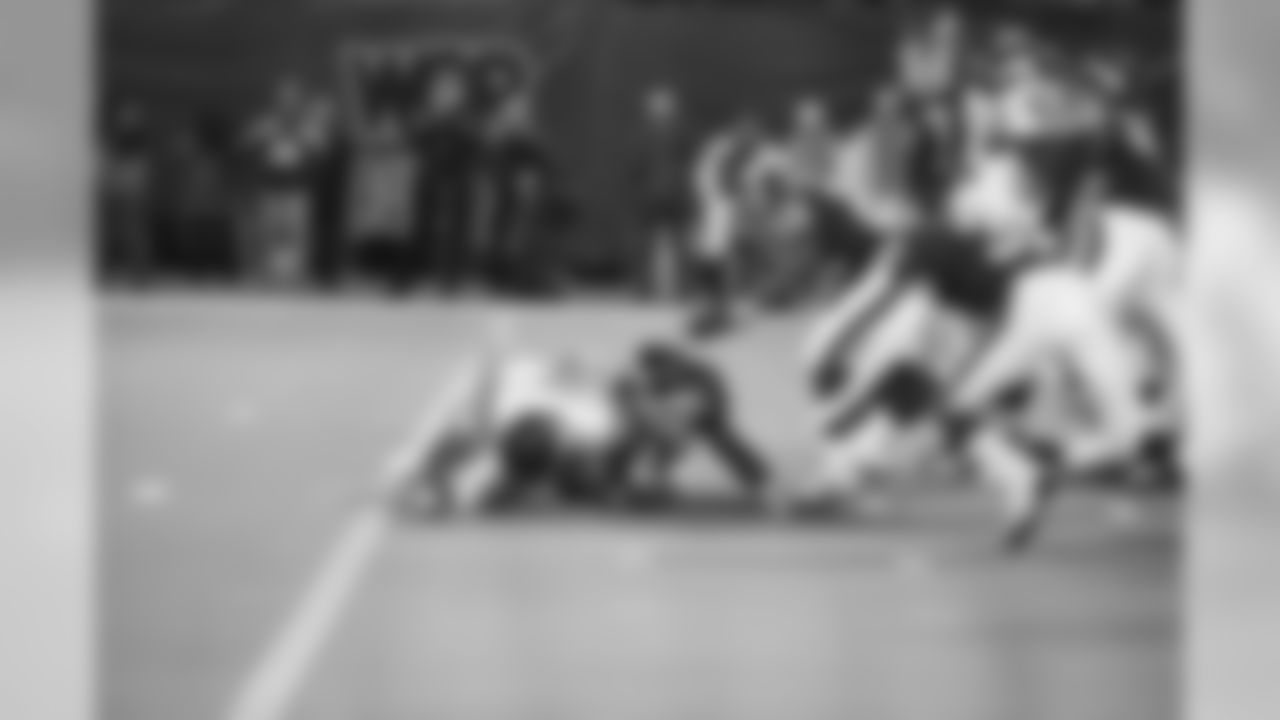
Minnesota Vikings quarterback Warren Moon, left, fights New York Giants right end Michael Strahan, center, after Moon fumbled during first period action of their NFL game at Giants Stadium in East Rutherford, New Jersey on Monday, Oct. 10, 1994. Giants cornerback Phillippi Sparks (22) is at right. (AP Photo/Bill Kostroun)

Cincinnati Bengals quarterback Jeff Black (8) hits the turf after being tripped up by New York Giants Michael Strahan (92) during the second quarter of their game at Giants Stadium in East Rutherford, New Jersey on Sunday, Dec. 11, 1994. Blake gained 4-yards on the play. (AP Photo/Mel Evans)

New York Giant's Victor Cruz, left, is joined by former Giants plyer Michael Strahan as they salsa dance during a ceremony for the NFL football Super Bowl XLVI champions at City Hall in New York, Tuesday, Feb. 7, 2012. (AP Photo/Craig Warga, Pool)

New York Giants' head coach Tom Coughlin, center, has water dumped on him by Osi Umenyiora, rear, and Michael Strahan, right, in the final minute against the Oakland Raiders in the fourth quarter of their in NFL football game in Oakland, Calif., Saturday, Dec. 31, 2005. The Giants won, 30-21. (AP Photo/Jeff Chiu)

New York Giants defensive end Michael Strahan, left, grabs Kansas City Chiefs quarterback Trent Green by the jersey during fourth quarter NFL football Saturday night, Dec. 17, 2005, at Giants Stadium in East Rutherford, N.J. The Giants won, 27-17. (AP Photo/Bill Kostroun)

Michael Strahan, left, of the New York Giants, and Tony Gonzalez of the Kansas City Chiefs, take questions during a press conference to promote the Pro Bowl during festivities for Super Bowl XL in Detroit Wednesday, Feb. 1, 2006. (AP Photo/Michael Conroy)

Left to right, Barry Sanders, who retired from the Detroit Lions, Michael Strahan of the New York Giants, Tony Gonzalez of the Kansas City Chiefs, and Antonio Gates of the San Diego Chargers speaks during a press conference to promote the Pro Bowl during festivities for Super Bowl XL in Detroit Wednesday, Feb. 1, 2006. (AP Photo/Michael Conroy)
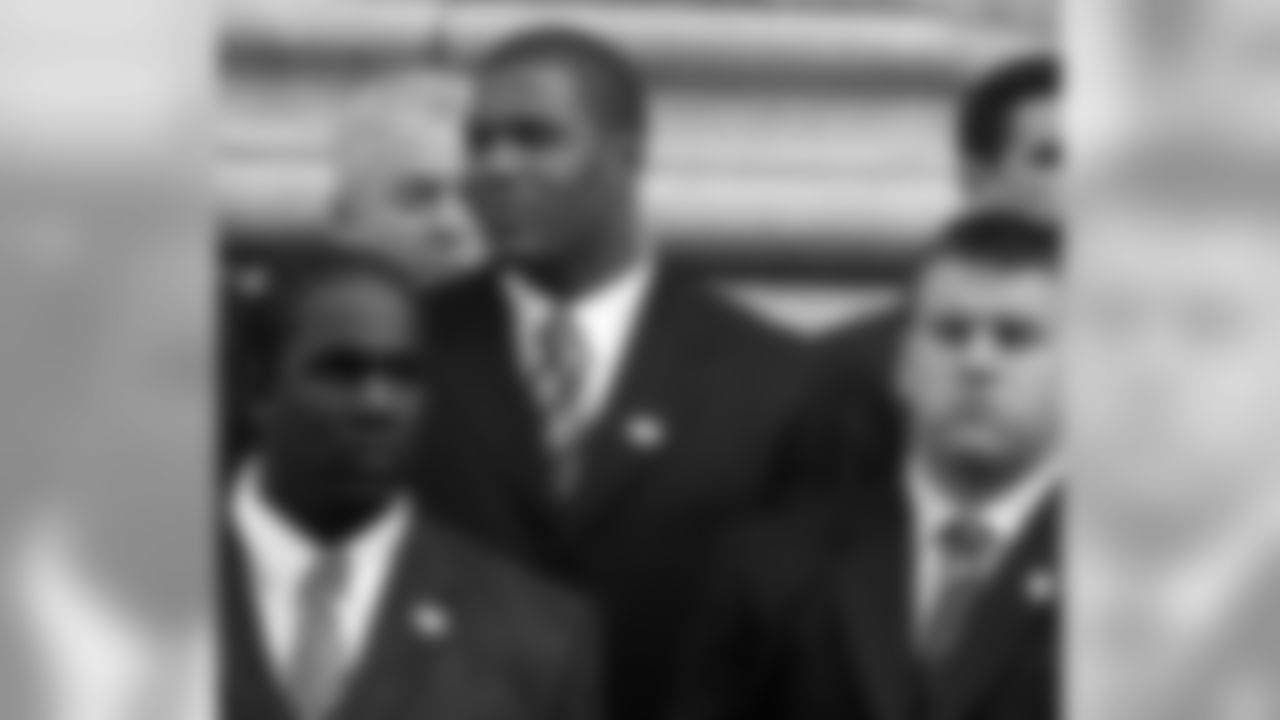
New York Giants defensive tackle Damane Duckett, left, defensive end Michael Strahan, center, and guard Chris Snee, right, leave St. Patrick's Cathedral in New York after the funeral of Giants owner Wellington Mara Friday, Oct. 28, 2005. Mara, who became co-owner of the Giants in 1930, died Tuesday at age 89. (AP Photo/Jason DeCrow)

Michael Strahan of the New York Giants laughs as he answers a question during a press conference to promote the Pro Bowl during festivities for Super Bowl XL in Detroit Wednesday, Feb. 1, 2006. (AP Photo/Michael Conroy)

New York Giants' Michael Strahan celebrates after the Giants scored a touchdown in the closing seconds to beat the Denver Broncos, 24-23, Sunday, Oct. 23, 2005 at Giants Stadium in East Rutherford, N.J. (AP Photo/Bill Kostroun)

New York Giants' Michael Strahan celebrates as he leaves the field after the Giants beat the San Francisco 49ers 24-6 in San Francisco on Sunday, Nov. 6, 2005. (AP Photo/Jeff Chiu)
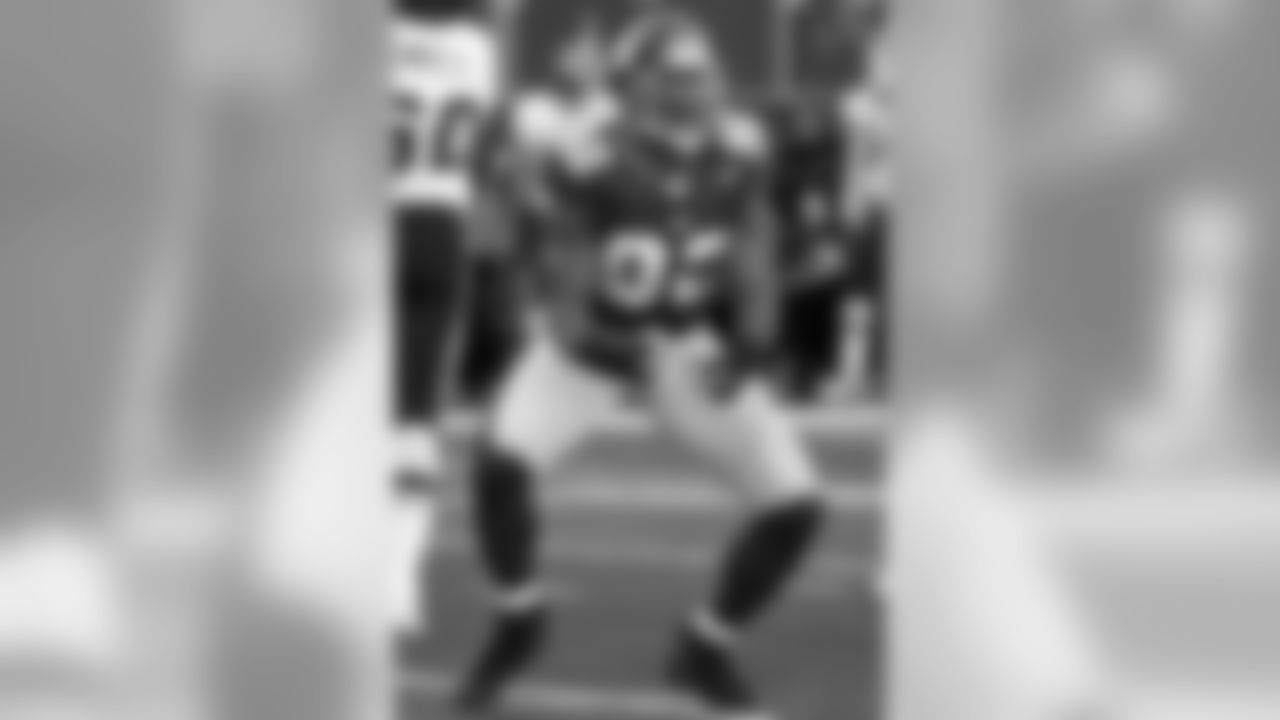
New York Giants defensive end Michael Strahan (92) celebrates after sacking Washington Redskins quarterback Mark Brunell during the first quarter Sunday, Oct. 30, 2005 at Giants Stadium in East Rutherford, N.J. The Giants had five sacks as they beat the Redskins 36-0. (AP Photo/Bill Kostroun)

New York Giants' Michael Strahan, left, and Jim Finn run onto the field to celebrate after beating the Denver Broncos, 24-23, Sunday, Oct. 23, 2005 at Giants Stadium in East Rutherford, N.J. (AP Photo/Bill Kostroun)

New York Giants defensive end Michael Strahan smiles during practice at mini-camp Wednesday, June 1, 2005, in East Rutherford, N.J. (AP Photo/Bill Kostroun)

Dallas Cowboys quarterback Drew Bledsoe (11) is sacked by New York Giants Michael Strahan (92) as teammate Gibril Wilson (28) looks on in the first quarter in Irving, Texas, Sunday, Oct. 16 , 2005. (AP Photo/LM Otero)

New York Giants defensive end Michael Strahan celebrates after sacking St. Louis Rams quarterback Marc Bulger during the second quarter Sunday, Oct. 2, 2005, at Giants Stadium in East Rutherford, N.J. The Giants won, 44-24. (AP Photo/Bill Kostroun)

New York Giants defensive lineman Michael Strahan is seen before the pre-season game against the New England Patriots at Gillette Stadium in Foxboro, Mass., Thursday, Sept. 1, 2005. The Giants defeated the Patriots 27-3. (AP Photo/Robert E. Klein)
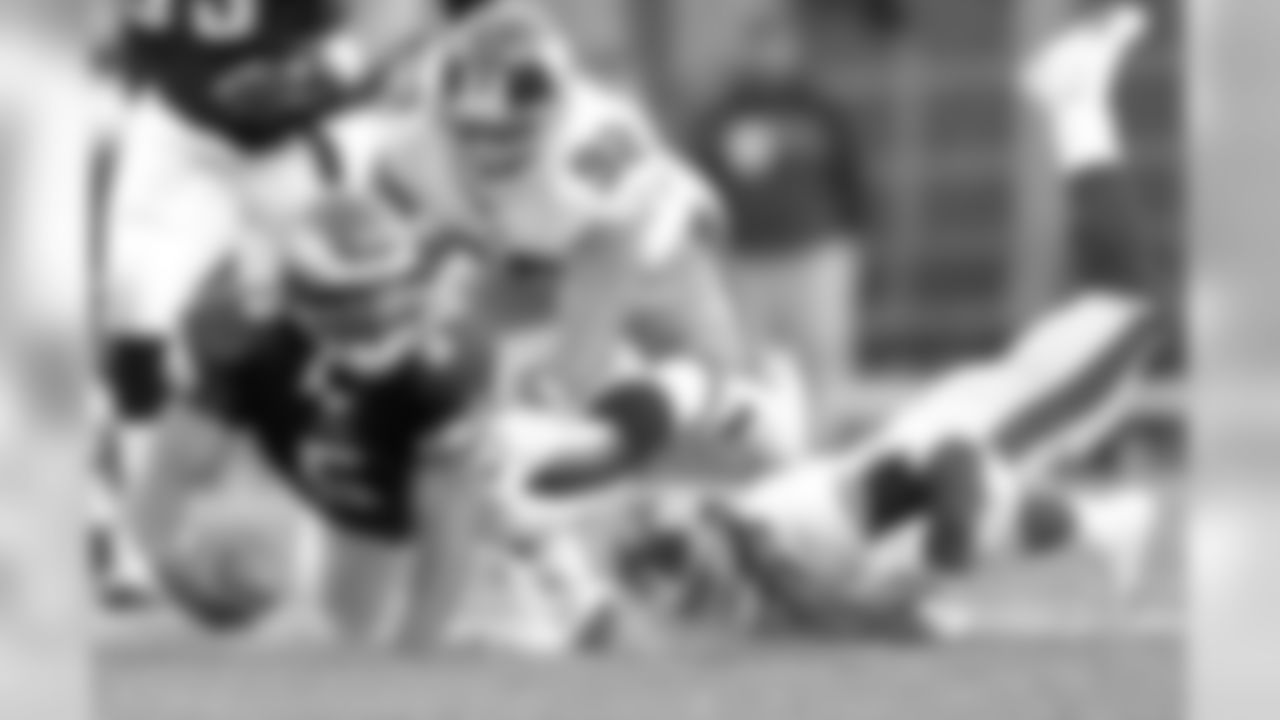
Philadelphia Eagles quarterback Donovan McNabb, left, dives for a two-yard gain ahead of tackle attempts by New York Giants saftey Omar Stoutmire, right, and defensive end Michael Strahan (92) during the fourth quarter Sunday, Nov. 16, 2003, in Philadelphia. The Eagles won 28-10. (AP Photo/Chris Gardner)

New York Giants' Michael Strahan reaches out to lasso a "bull" at the finish line of the "Mama's Boys" and their Mom's Tackle Hunger race Tuesday, Jan. 27, 2004, in Houston. Strahan, Philadelphia Eagles' Donovan McNabb, Tampa Bay Bucaneers' John Lynch and their mothers participated in the Chunky Wagon Challenge race, a race to help raise donations for America's Second Harvest food banks. (AP Photo/Brett Coomer)

Philadelphia Eagles running back Dorsey Levans, right, is stopped by New York Giants' Mike Barrow, (58), Shaun Williams, (38), Brandon Short (53), and Michael Strahan, (92), during the second quarter Saturday, Dec. 28, 2002 in East Rutherford, N.J. The Giants won 10-7 in overtime giving them a wildcard berth in the playoffs. (AP Photo/Chris Gardner)

New York Giants defensive end Michael Strahan celebrates after sacking Seattle Seahawks quarterback Trent Dilfer during the third quarter Sunday, Sept. 22, 2002, at Giants Stadium in East Rutherford, N.J. The Giants beat the Seahawks 9-6. (AP Photo/Bill Kostroun)

New York Giants' Michael Strahan (92) flexes his muscle after sacking Houston Texans quarterback David Carr during the first quarter Sunday, Nov. 24, 2002, in Houston. (AP Photo/Richard Carson)

New York Giants defensive end Michael Strahan picks up a fumble and runs by Seattle Seahawks fullback Mack Strong for a 13-yard touchdown at Giants Stadium in East Rutherford, N.J., Dec. 23, 2001. (AP Photo/Bill Kostroun)

San Francisco 49ers quarterback Jeff Garcia is pressured by New York Giants defensive end Michael Strahan in the second period Thursday, Sept. 5, 2002 in East Rutherford, N.J. Garcia's pass was incomplete. (AP Photo/Mark Lennihan)

New York Giants Michael Strahan hits St. Louis Quarterback Kurt warner after he releases the ball in the third quarter Sunday, October 14, 2001 at the Dome at Americas Center in St. Louis.(AP Photo/Tom Gannam)

Philadelphia Eagles quarterback Donovan McNabb tries to dodge New York Giants Mike Barrow, Michael Strahan and Jason Sehorn in the fourth quarter at Giants Stadium in East Rutherford, N.J., Monday, Oct. 22, 2001. McNabb was sacked on the play but the Eagles went on to win 10-9. (AP Photo/Jeff Zelevansky)

Replacement referee Ernie Briggs instructs members of the New York Giants and Baltimore Ravens during the coin toss before a preseason game in Baltimore, Friday, Aug. 31, 2001. From left are New York Giants Jessie Armstead (98) Michael Strahan (92) and Baltimore Ravens' Ray Lewis. (AP Photo/Roberto Borea)

New York Giants defensive ends Michael Strahan, left, and Cedric Pittman try to keep cool on the sidelines during an intrasquad scrimmage Saturday, Aug. 4, 2001, in Albany, N.Y. (AP Photo/Dave Oxford)

New York Giants Michael Strahan smiles as he talks to the media at a news conference Monday, Jan. 15, 2001, in East Rutherford, N.J. The Giants will play the Baltimore Ravens in the Super Bowl. (AP Photo/Bill Kostroun)

New York Giants defensive end Michael Strahan laughs during a news conference at New York's Inter-Continental Hotel Friday, Jan. 12, 2001. The Giants will face the Minnesota Vikings Sunday, Jan. 14, in the NFC Championship. (AP Photo/Mark Lennihan)

New England Patriots head coach Bill Belichick., right, is congratulated by New York Giants defensive end Michael Strahan after the Patriots 38-35 victory over the Giants in their NFL football game at Giants Stadium in East Rutherford, N.J., on Saturday, Dec. 29, 2007. The Patriots became the first team to go 16-0 in the regular season and the first since the 1972 Miami Dolphins to go through a full schedule without a loss. (AP Photo/Kathy Willens)

Dallas Cowboys quarterback Anthony Wright (2) hits the ground after being sacked by New York Giants defensive end Michael Strahan in the fourth quarater Sunday, Dec. 17, 2000 in Irving, Texas. (AP Photo/Donna McWilliam)

Green Bay Packers quarterback Brett Favre (4) pats New York Giants defensive end Michael Strahan (92) after Strahan sacked him for the NFL sack record during the fourth quarter Sunday, Jan. 6, 2002, at Giants Stadium in East Rutherford, N.J. The sack gave Strahan 22.5 sacks for the season surpassing New York Jets Mark Gastineau's NFL record of 22 sacks. Giants defensive tackle Cornelius Griffin (97) congratulates Strahan.(AP Photo/Bill Kostroun)

Michael Strahan Has his #92 jersey retired at halftime during a week 12 football game against the Philadelphia Eagles on Sunday November 28th, 2021 in East Rutherford, New Jersey


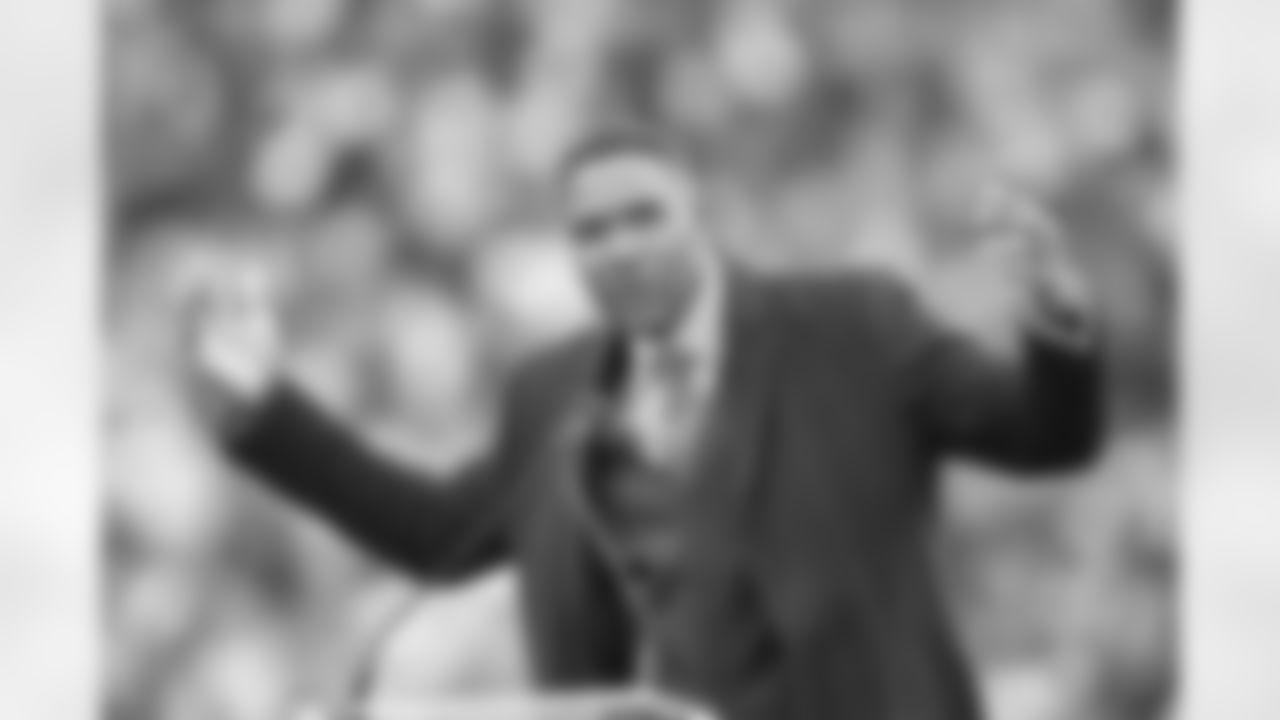
Halftime Michael Strahan



Michael Strahan has his Jersey retired during a week 12 football game against the Philadelphia Eagles on Sunday November 28th, 2021 in East Rutherford, New Jersey




Jessie Armstead and Tom Coughlin show off Michael Strahans framed Jersey during a week 12 football game against the Philadelphia Eagles on Sunday November 28th, 2021 in East Rutherford, New Jersey

Michael Strahan has his #92 jersey retired at halftime during a week 12 football game against the Philadelphia Eagles on Sunday November 28th, 2021 in East Rutherford, New Jersey



Jessie Armstead and Tom Coughlin show off Michael Strahans framed Jersey during a week 12 football game against the Philadelphia Eagles on Sunday November 28th, 2021 in East Rutherford, New Jersey

Michael Strahan has his Jersey retired during a week 12 football game against the Philadelphia Eagles on Sunday November 28th, 2021 in East Rutherford, New Jersey

Michael Strahan Has his #92 jersey retired at halftime during a week 12 football game against the Philadelphia Eagles on Sunday November 28th, 2021 in East Rutherford, New Jersey

Michael Strahan Has his #92 jersey retired at halftime during a week 12 football game against the Philadelphia Eagles on Sunday November 28th, 2021 in East Rutherford, New Jersey

Michael Strahan Has his #92 jersey retired at halftime during a week 12 football game against the Philadelphia Eagles on Sunday November 28th, 2021 in East Rutherford, New Jersey

Michael Strahan Has his #92 jersey retired at halftime during a week 12 football game against the Philadelphia Eagles on Sunday November 28th, 2021 in East Rutherford, New Jersey
Dan Salomone: I'm going to disagree with Schmeelk. You can count Eli Manning in the 2004 class, and the recently-retired two-time Super MVP makes it the best one in franchise history. Even when you count Philip Rivers as the pick, he was still an asset that helped acquire Manning. Therefore, 2004 stands. In addition to Manning, it produced Chris Snee, who will be joined by No. 10 in short order in the Ring of Honor. Additionally, Gibril Wilson was a fifth-round choice in the same class. Just ask Randy Moss and Tom Brady about his impact in Super Bowl XLII.
But don't take our word for it. The fans actually voted on this very subject a few years ago in our "Giants Bracket Challenge" on Giants.com. What we discovered is that no matter what the category is, Lawrence Taylor always wins.
Beginning with a pool of 16, fans voted round by round each week, whittling the bracket down to eight and then to a final four, which consisted of 1981 (L.T., Billy Ard, Byron Hunt) vs. 2003 (Osi Umenyiora, David Diehl, David Tyree) and 1984 (Carl Banks, William Roberts, Jeff Hostetler, Gary Reasons) vs. 2005 (Corey Webster, Justin Tuck, Brandon Jacobs).
The two classes from the 1980s prevailed and in a tight championship race, 1981 edged out 1984 by 49 votes, or 53-47 percent. To get there, 1981 knocked out 2004 (72-28 percent), 1956 (81-19), and 2003 in the semifinals (67-33).
Here were the 16 classes:
GIANTS STADIUM REGION
- 1983: DB Terry Kinard, DE Leonard Marshall, TE Jamie Williams, T Karl Nelson, DB Perry Williams, LB Andy Headen, K Ali Haji-Sheikh
- 1965: RB Tucker Frederickson, RB Chuck Mercein, DB Willie Williams, RB Ernie Koy, DB Spider Lockhart
- 1987: WR Mark Ingram, WR Stephen Baker, WR Odessa Turner, T Doug Riesenberg,
- 2003: DT William Joseph, DE Osi Umenyiora, TE Visanthe Shiancoe, DB Rod Babers, T David Diehl, WR Willie Ponder, CB Frank Walker, WR David Tyree
POLO GROUNDS REGION
- 2004: QB Philip Rivers, G Chris Snee, LB Reggie Torbor, S Gibril Wilson
- 1981: LB Lawrence Taylor, G Billy Ard, LB Byron Hunt
- 1986: DE Eric Dorsey, DB Mark Collins, NT Erik Howard, LB Pepper Johnson
- 1956: LB Sam Huff, DE Jim Katcavage, K Don Chandler
METLIFE STADIUM REGION
- 1984: LB Carl Banks, G William Roberts, QB Jeff Hostetler, LB Gary Reasons, WR Lionel Manuel
- 1979: QB Phil Simms, WR Earnest Gray
- 2007: CB Aaron Ross, WR Steve Smith, NT Jay Alford, LB Zak DeOssie, TE Kevin Boss, S Michael Johnson, RB Ahmad Bradshaw
- 1993: DE Michael Strahan, LB Jessie Armstead
YANKEE STADIUM REGION
- 1989: C Brian Williams, G Bob Kratch, DB Greg Jackson, RB Dave Meggett, TE Howard Cross, DB Myron Guyton
- 1997: WR Ike Hilliard, RB Tiki Barber, LB Ryan Phillips, P Brad Maynard, SS Sam Garnes
- 2005: CB Corey Webster, DE Justin Tuck, RB Brandon Jacobs
- 1955: DT Rosey Grier, FB Mel Triplett, DB Jimmy Patton
Lance Medow: There's a few strong candidates. You can go with 1984, which showcased Carl Banks, William Roberts, Jeff Hostetler, Gary Reasons and Lionel Manuel. The 2003 class had Osi Umenyiora, David Diehl and David Tyree, and 2007 wasn't too shabby with Aaron Ross, Steve Smith, Zak DeOssie, Kevin Boss and Ahmad Bradshaw. You can make a case for all three of those groups, but to me, the one that tops the list is 2005. That year the Giants had just four picks (none in the first round because of the Eli Manning trade) and wound up with Corey Webster (2nd round), Justin Tuck (third round) and Brandon Jacobs (4th round) with their top three picks. All three of those players helped the team win a pair of Super Bowls in the span of five seasons and all three played at least eight seasons with the team.
From a value standpoint, the Giants hit a home run with this class because Webster, Tuck and Jacobs all became key starters and all earned second contracts with the team. That's the goal with any draft class. You're not just renting the players for the length of their rookie deals. You want them to give you a reason to offer a new deal and that happened with all three of these players. In a year when the Giants had no first round picks, they still walked away with plenty of substance and depth. That's pretty impressive. The 1984 class also runs deep and contributed to two Super Bowl victories, so you can't go wrong with that group, but I'd give 2005 the slight edge because the Giants didn't make a selection until the 43rd pick and managed to retain all three of those players during the salary cap era. It's important to take into consideration the environment surrounding the class as much as the individual talent.

Giants App
Download the Giants' official app for iPhone, iPad and Android devices


















